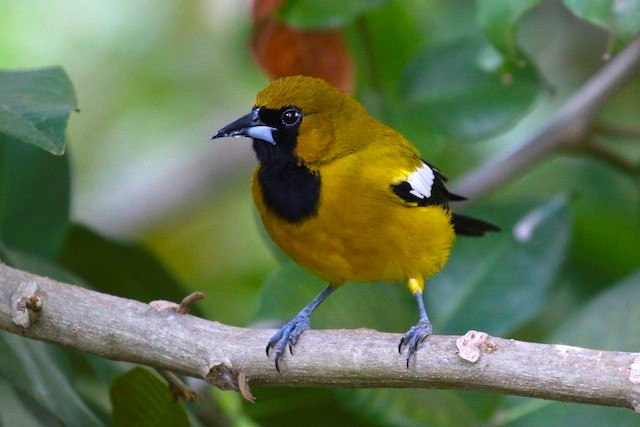Birdfinding.info ⇒ Readily found at most of the frequently visited Jamaican sites, such as Rocklands Bird Sanctuary, Marshall’s Pen, San San, Ecclesdown Road, and throughout Cockpit Country and the Blue Mountains. Also easy to find on Isla San Andrés, where it is one of the predominant resident landbirds.
Jamaican Oriole
Icterus leucopteryx
Endemic to two widely separated islands, Jamaica and Isla San Andrés (i.e., the Colombian offshore territory about 200 km east of central Nicaragua). Widespread and common in most wooded habitats, including large gardens, on both islands.
Extirpated from Grand Cayman around 1967.
Identification
A distinctive olive-yellow oriole with a black mask and bib and extensive white in its wings. Has a heavy bill with a contrasting pale blue triangle at the base of the lower mandible. The sexes are similar except that males are more yellow, females more olive.

Jamaican Oriole. (Rocklands Bird Sanctuary, Jamaica; February 2012.) © Ignacio Yúfera
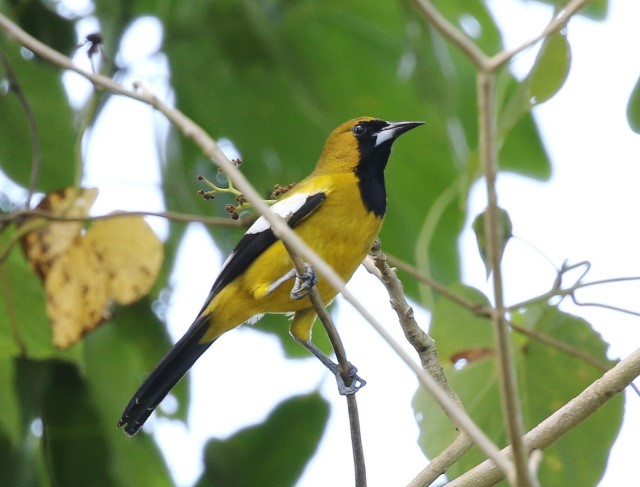
Jamaican Oriole. (Green Castle Estate, Jamaica; February 2018.) © Paul and Sally Bartho
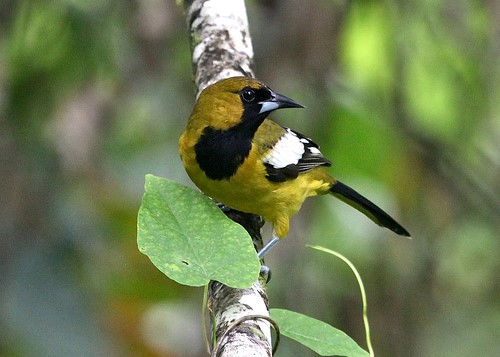
Jamaican Oriole. (Ecclesdown Road, Jamaica; April 14, 2014.) © Gil Ewing

Jamaican Oriole, frontal and dorsal view. (Silver Hill Gap, Jamaica; February 26, 2012.) © Kurt Hennige

Jamaican Oriole. (Marshall’s Pen, Jamaica; July 7, 2008.) © Steve Metz
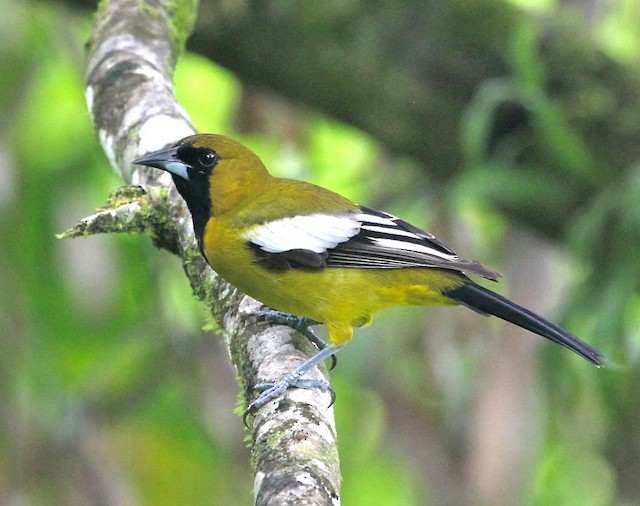
Jamaican Oriole. (Ecclesdown Road, Jamaica; April 14, 2014.) © Gil Ewing

Jamaican Oriole. (Rocklands Bird Sanctuary, Jamaica; March 12, 2016.) © David Disher
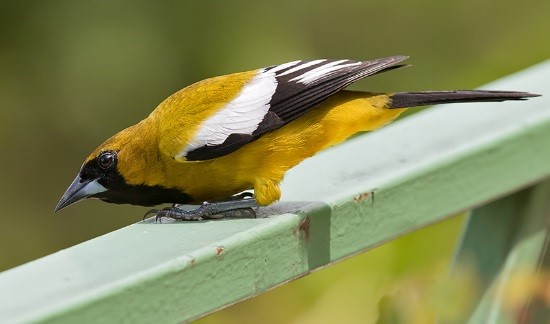
Jamaican Oriole. (Silver Hill Gap, Jamaica; March 25, 2015.) © Sam Woods
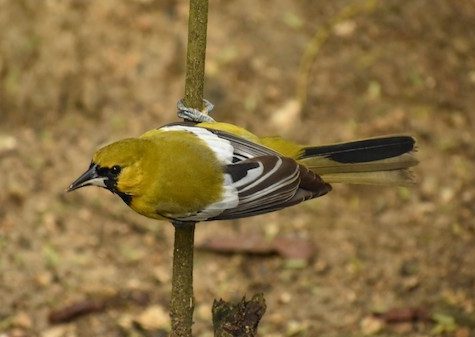
Jamaican Oriole, I. l. lawrencii. (Manglares de Old Point National Park, Isla San Andrés, Colombia; January 10, 2016.) © Orlando Acevedo Charry
Immatures resemble adults, but are greener or dusky-yellow and have a dark bar across the white wing patch—sometimes appearing as two white wingbars—and a more extensively pale bill.
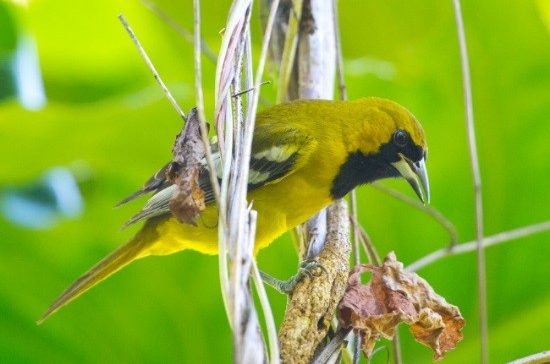
Jamaican Oriole, immature. (Hardwar Gap, Jamaica; February 2014.) © Tom Davis
The immature plumage resembles young male Hooded and Orchard Orioles in being greenish-yellow with a black mask and bib and white wingbars. Neither of those species is known to occur regularly on Jamaica or San Andrés, but Orchard is highly migratory, regular on Cuba, and a vagrant to Jamaica, and Hooded has been recorded as a vagrant to Cuba. Compared to both of those species, Jamaican is larger, with a much heavier and paler bill, a more extensive black bib, bolder wingbars, and additional white highlights in the wings.

Jamaican Oriole, I. l. lawrencii, immature. (Manglares de Old Point National Park, Isla San Andrés, Colombia; February 6, 2011.) © Flowzim
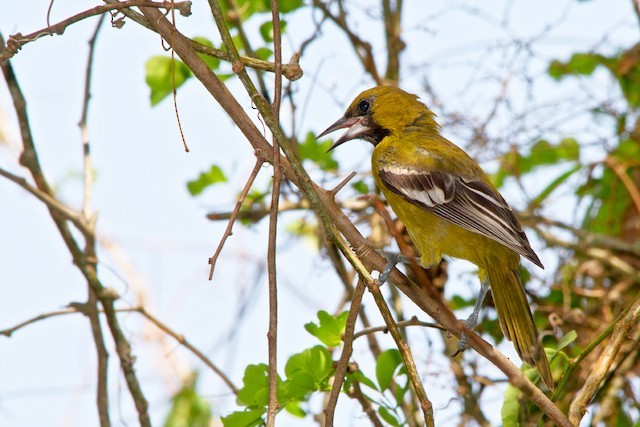
Jamaican Oriole, immature. (Rocklands Bird Sanctuary, Jamaica; August 31, 2018.) © Piet Grasmaijer
Voice. Common call is a whistled three-syllable phrase repeated a few times in quick succession, punctuated by a final whistle:
Notes
Polytypic species consisting of three recognized subspecies: leucopteryx (Jamaica), lawrencii (Isla San Andrés), and bairdi (Grand Cayman Island).
Bairdi was last reported in 1967 and is certainly extinct. It had the same plumage pattern as the existing subspecies, but was bright orange-yellow instead of olive.
References
eBird. 2018. eBird: An online database of bird distribution and abundance. Cornell Lab of Ornithology, Ithaca, N.Y. http://www.ebird.org. (Accessed October 18, 2018.)
Fraga, R. 2018. Jamaican Oriole (Icterus leucopteryx). In Handbook of the Birds of the World Alive (J. del Hoyo, A. Elliott, J. Sargatal, D.A. Christie and E. de Juana, eds.). Lynx Edicions, Barcelona. https://www.hbw.com/node/62252. (Accessed October 18, 2018.)
Haynes-Sutton, A., A. Downer, R. Sutton, and Y.-J. Rey-Millet. 2009. A Photographic Guide to the Birds of Jamaica. Princeton University Press, Princeton, N.J.
Jaramillo, A., and P. Burke. 1999. New World Blackbirds: The Icterids. Princeton University Press, Princeton, N.J.
Raffaele, H., J. Wiley, O. Garrido, A. Keith, and J. Raffaele. 1998. A Guide to the Birds of the West Indies. Princeton University Press, Princeton, N.J.
